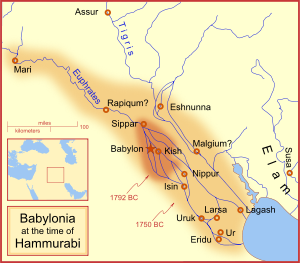- Kutha
-
Coordinates: 32°45′36.1″N 44°36′46.3″E / 32.760028°N 44.612861°E
Kutha, Cuthah, or Cutha (Sumerian: Gudua, modern Tell Ibrahim, Babil Governorate, Iraq) was an ancient city of Sumer on the right bank of the eastern branch of the Upper Euphrates, north of Nippur and around 25 miles northeast of Babylon. It should not be confused with the site Tell Ibrahim Awad in Egypt.
Contents
History
According to the Tanakh, Cuthah was one of the five Syrian and Mesopotamian cities from which Sargon II, King of Assyria, brought settlers to take the places of the exiled Israelites (2 Kings 17:24-30). II Kings relates that these settlers were attacked by lions, and interpreting this to mean that their worship was not acceptable to the deity of the land, they asked Sargon to send someone to teach them, which he did.
The result was a mixture of religions and peoples, the latter being known as "Cuthim" in Hebrew and as "Samaritans" to the Greeks.[1]
Kutha is also the name of the capital of the Sumerian underworld, Irkalla [2]
In the Assyrian inscriptions "Cutha" occurs on the Shalmaneser obelisk, line 82, in connection with Babylon. Shulgi (formerly read as Dungi), King of Ur III, built the temple of Nergal at Cuthah,[3] which fell into ruins, so that Nebuchadnezzar II had to rebuild the "temple of the gods, and placed them in safety in the temple".[4] This agrees with the Biblical statement that the men of Cuthah served Nergal.[5] Josephus places Cuthah, which for him is the name of a river and of a district,[6] in Persia, and Neubauer[7] says that it is the name of a country near Kurdistan.
The so-called "Legend of the King of Cuthah", a fragmentary inscription of the Akkadian literary genre called narû, written as if it were transcribed from a royal stele, is in fact part of the "Legend of Naram-Sin", not to be read as history, found in the cuneiform library at Sultantepe, north of Harran.[8]
Sumu-la-El, a king of the 1st Babylonian Dynasty, rebuilt the city walls of Kutha.[9] The city was later defeated by Hammurabi of Babylon in the 39th year of his reign.[10]
Archaeology
The site of Kutha consists of a 3/4 mile long crescent shaped main mound with a smaller mound to the west. The two mounds, as is typical in the region, are separated by the dry bed of an ancient canal, the Shatt en-Nil.
The first archaeologist to examine the site, George Rawlinson, noted a brick of king Nebuchadrezzar II of the Neo-Babylonian Empire mentioning the city of Kutha. The site was also visited by George Smith and by Edgar James Banks. [11] Tell Ibrahim was excavated by Hormuzd Rassam in 1881, for 4 weeks. Little was discovered, mainly some inscribed bowls and a few tablets. [12] [13]
Notes
- ^ Josephus, Antiquities of the Jews ix. 14, § 3
- ^ [1] Alfred Jeremias, The Babylonian conception of heaven and hell, D. Nutt, 1902
- ^ Year Names of Shulgi at CDLI
- ^ ib. 51b
- ^ II Kings xvii. 30
- ^ Josephus, Antiquities of the Jews, ix. 14, § 1, 3
- ^ Adolf Neubauer, La Géographie du Talmud, p. 379, 1968
- ^ O. R. Gurney, The Sultantepe Tablets (Continued). IV. The Cuthaean Legend of Naram-Sin, Anatolian Studies, vol. 5, pp. 93-113, 1955
- ^ Year Names of Sumulael at CDLI
- ^ Year Names of Hammurabi at CDLI
- ^ Edgar James Banks, Cutha, The Biclical World, sol. 22, no. 1, pp. 61-64, 1903
- ^ [2] Hormuzd Rassam, Asshur and the Land of Nimrod: Being an Account of the Dicoveries Made in the Ancient Ruins of Nineveh, Asshur, Sepharvaim, Calah, [etc]..., Curts & Jennings, 1897
- ^ J. E. Reade, Rassam's Excavations at Borsippa and Kutha 1879-82, Iraq, vol. 48, pp. 105-116, 1986
See also
References
- Julian Reade, Hormuzd Rassam and His Discoveries, Iraq, vol. 55, pp. 39-62, 1963
External links
This article incorporates text from the 1901–1906 Jewish Encyclopedia article "Cuthah" by Emil G. Hirsch and Gerson B. Levi, a publication now in the public domain.
Categories:- Samaritan culture and history
- Hebrew Bible places
- Archaeological sites in Iraq
- Former populated places in Iraq
Wikimedia Foundation. 2010.

